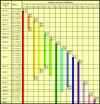13q Deletion and central nervous system anomalies: further insights from karyotype-phenotype analyses of 14 patients
- PMID: 17209130
- PMCID: PMC2597907
- DOI: 10.1136/jmg.2006.043059
13q Deletion and central nervous system anomalies: further insights from karyotype-phenotype analyses of 14 patients
Abstract
Background: Chromosome 13q deletion is associated with varying phenotypes, which seem to depend on the location of the deleted segment. Although various attempts have been made to link the 13q deletion intervals to distinct phenotypes, there is still no acknowledged consensus correlation between the monosomy of distinct 13q regions and specific clinical features.
Methods: 14 Italian patients carrying partial de novo 13q deletions were studied. Molecular-cytogenetic characterisation was carried out by means of array-comparative genomic hybridisation (array-CGH) or fluorescent in situ hybridisation (FISH).
Results: Our 14 patients showed mental retardation ranging from profound-severe to moderate-mild: eight had central nervous system (CNS) anomalies, including neural tube defects (NTDs), six had eye abnormalities, nine had facial dysmorphisms and 10 had hand or feet anomalies. The size of the deleted regions varied from 4.2 to 75.7 Mb.
Conclusion: This study is the first systematic molecular characterisation of de novo 13q deletions, and offers a karyotype-phenotype correlation based on detailed clinical studies and molecular determinations of the deleted regions. Analyses confirm that patients lacking the 13q32 band are the most seriously affected, and critical intervals have been preliminarily assigned for CNS malformations. Dose-sensitive genes proximal to q33.2 may be involved in NTDs. The minimal deletion interval associated with the Dandy-Walker malformation (DWM) was narrowed to the 13q32.2-33.2 region, in which the ZIC2 and ZIC5 genes proposed as underlying various CNS malformations are mapped.
Conflict of interest statement
Competing interests: None declared.
References
-
- Tranebjaerg L, Brøndum‐Nielsen K, Tommerup N, Warburg M, Mikkelsen M. Interstitial deletion 13q: further delineation of the syndrome by clinical and high resolution chromosome analysis of five patients. Am J Med Genet 198829739–753. - PubMed
-
- Brown S, Gersen S, Anyane‐Yeboa K, Warburton D. Preliminary definition of a “critical region” of chromosome 13 in q32: report of 14 cases with 13q deletions and review of the literature. Am J Med Genet 19934552–59. - PubMed
-
- Van Buggenhout G, Trommelen J, Hamel B, Fryns J P. 13q deletion syndrome in an adult mentally retarded patient. Genet Couns 199910(2)177–181. - PubMed
-
- Niebuhr E. Partial trisomies and deletions of chromosome 13. In: Yunis JJ, ed. New chromosomal syndromes. New York: Academic Press, 1977273–299.
Publication types
MeSH terms
Substances
LinkOut - more resources
Full Text Sources
Miscellaneous

